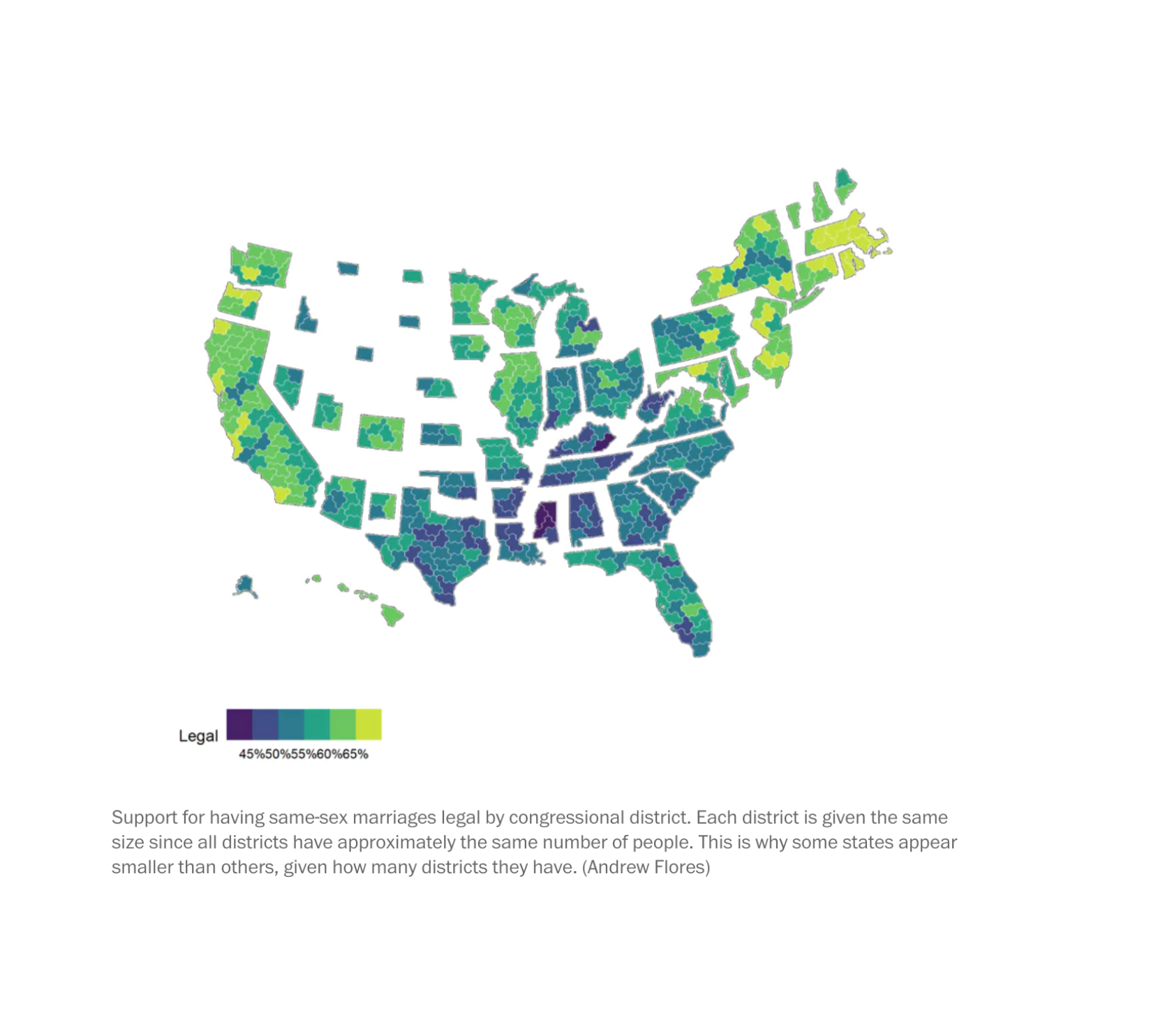Last month, the U.S. House passed the Respect for Marriage Act, supported by all 250 House Democrats and 47 Republicans. The bill hasn’t yet been taken up by the Senate. Here at The Washington Post, a recent analysis suggests that the Republicans who voted for the bill come from Democratic-leaning or politically moderate districts.
On LGB rights (transgender rights have yet to be examined), recent research finds that members of Congress typically vote in keeping with their constituents’ opinions. But elected officials — especially Republicans — tend to overestimate how conservative their constituents are. So did Republican members of Congress misunderstand what their constituents think should be law on the Respect for Marriage Act?
Estimating public support for marriage equality by congressional districts
To investigate this, I used the Democracy Fund + UCLA Nationscape survey data, a sample of opinions of about 500,000 interviews with Americans that includes detailed geographic data. In two waves of data collection in the spring of 2020 and 2021, 19,024 respondents were asked, “We’d like to know whether you agree or disagree with each of the following policies: make gay marriage illegal.” Nationwide, 58 percent disagreed, 26 percent agreed and 16 percent had no opinion. This overall pattern is consistent with a recent Politico/Morning Consult poll that showed 58 percent of U.S. adults supported passage of the Respect for Marriage Act.
Political scientists have developed reliable methods of analyzing national survey data to assess attitudes by congressional districts through a technique called multilevel regression and post-stratification. I used this to estimate the percent of people within a congressional district who did not agree with making marriages for same-sex couples illegal — who said, in other words, that same-sex couples should continue to be able to marry.
Legal marriage for same-sex couples is broadly popular in almost every congressional district
Out of 435 congressional districts, I found only 45 congressional districts in which less than a majority of adult residents opposed making same-sex marriage illegal. That doesn’t mean a majority supported making marriage equality illegal, since some had no opinion; it just means there wasn’t a majority in favor of keeping it legal.
In other words, in roughly 90 percent of U.S. congressional districts, a majority of voters support marriage rights for same-sex couples.
The districts without a majority in favor of legal marriage equality tended to be in the South; but given the numbers, in many congressional districts in the South, a majority support marriage equality. If members of Congress vote in line with their district’s beliefs, even more House Republicans should have voted in favor of the bill, leaving only 45 holdouts, as you can see in the figure below.
Political scientists have developed the concept of policy congruence, which evaluates how much elected officials’ decisions match their constituents’ desires. With that, we can create what we call a “policy characteristic curve” — a line that relates constituent opinions to the probability that a member of Congress will vote according to those opinions. If a lawmaker is much likelier to favor a policy if a majority of their constituents support it, then there is a high degree of congruence. But if more than a simple majority is necessary on liberal policies before the lawmaker is likely to support it, then some scholars call this a conservative bias.
When evaluating all House members’ votes on the bill against their district’s opinions, I actually found a strong degree of congruence. Districts in which a majority favored marriage equality were represented by House members who voted for the bill. But I did find some conservative bias. House members were far more likely to vote for the bill when about 54 percent of their constituents supported marriage equality.
However, House Republicans on average had to come from a district with over 60 percent support before they voted in favor of the bill. Since all Democrats supported the bill, we can’t do a similar analysis for them. Though, the lowest level of support in Democratic district was 42 percent, and there were 14 districts where estimates were less than a majority support. The 47 Republicans who voted yes did so when a majority of at least 50 percent of their constituents supported marriage equality. Among House Republicans who voted no, 130 did even when a majority of their constituents supported marriage equality.
What will happen in the Senate?
In only six states, a majority does not approve of legal marriage recognition: Alabama, Arkansas, Kentucky, Mississippi, Oklahoma and West Virginia, with Mississippi having the lowest level of support at 43 percent. If all senators were going to represent their constituents’ opinions, the marriage equality bill would get 88 votes in favor.
Some Senate Republicans have signaled that they may support the bill, including Sens. Susan Collins (Maine), Thom Tillis (N.C.), Rob Portman (Ohio) and Lisa Murkowski (Alaska). If senators were voting in line with their constituents’ opinions, the additional six votes for passage would come from remaining states with the largest pro-marriage equality majorities, which would be Sens. Ron Johnson (Wis.), Kevin Cramer and John Hoeven (N.D.), Joni Ernst and Charles E. Grassley (Iowa), and Mike Lee or Mitt Romney (Utah). Of these, only Johnson has said he sees “no reason to oppose the bill.” (He subsequently told the Milwaukee Journal Sentinel that he had some concerns.)
Changing lawmakers’ information flows may offer limited help to update their perceptions
Of course, lawmakers don’t necessarily vote to represent their whole constituents’ opinions and may respond to attentive subgroups. But if they were to want to represent their constituents at large, what might help correct this bias?
A simple fix might be to have more constituents call or write their representatives. Recent research finds that elected officials mostly hear from conservative constituents.
The massive opinion change on legal marriage recognition for same-sex couples remains one of the most notable shifts in opinion in recent history. Some elected officials may not have fully absorbed the breadth of that change.
